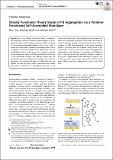Density functional theory study of Pd aggregation on a pyridine-terminated self-assembled monolayer
Abstract
By using density functional theory calculations, the initial steps towards Pd metal cluster formation on a pyridine‐terminated self‐assembled monolayer (SAM) consisting of 3‐(4‐(pyridine‐4‐yl)phenyl)propane‐1‐thiol on an Au(1 1 1) surface are investigated. Theoretical modelling allows the investigation of structural details of the SAM surface and the metal/SAM interface at the atomic level, which is essential for elucidating the nature of Pd–SAM and Pd–Pd interactions at the liquid/solid interface and gaining insight into the mechanism of metal nucleation in the initial stage of electrodeposition. The structural flexibility of SAM molecules was studied first and the most stable conformation was identified, planar molecules in a herringbone packing, as the model for Pd adsorption. Two binding sites are found for Pd atoms on the pyridine end group of the SAM. The strong interaction between Pd atoms and pyridines illustrates the importance of SAM functionalisation in the metal nucleation process. Consistent with an energetic driving force of approximately −0.3 eV per Pd atom towards Pd aggregation suggested by static calculations, a spontaneous Pd dimerisation is observed in ab initio molecular dynamic studies of the system. Nudged elastic band calculations suggest a potential route with a low energy barrier of 0.10 eV for the Pd atom diffusion and then dimerisation on top of the SAM layer.
Citation
Yao , Z , Buck , M & Buehl , M 2020 , ' Density functional theory study of Pd aggregation on a pyridine-terminated self-assembled monolayer ' , Chemistry - A European Journal , vol. 26 , no. 46 , pp. 10555-10563 . https://doi.org/10.1002/chem.202001242
Publication
Chemistry - A European Journal
Status
Peer reviewed
ISSN
0947-6539Type
Journal article
Description
Authors thank the School of Chemistry and EaStCHEM for support. The Chinese Scholarship Council is gratefully acknowledged for a stipend for Z. Y.Collections
Items in the St Andrews Research Repository are protected by copyright, with all rights reserved, unless otherwise indicated.

